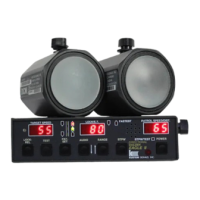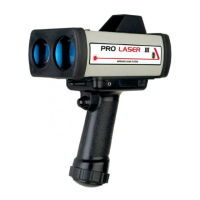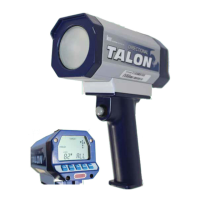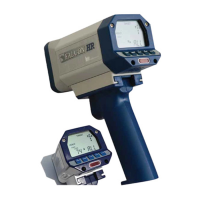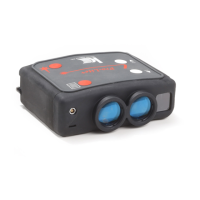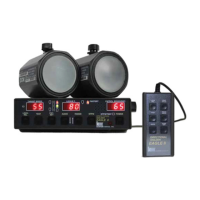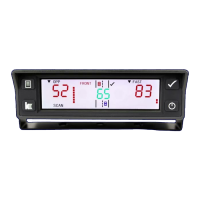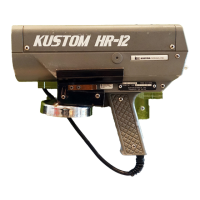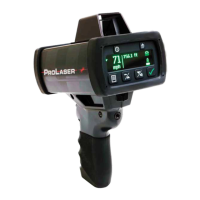Do you have a question about the Kustom Signals Directional Golden Eagle II and is the answer not in the manual?
Details system type, frequency, accuracy, voltage, and components.
Covers speed processor, self-tests, lock time, display types, and speed response.
Describes various windows, display types, light intensity, and automatic clear functions.
Details speed ranges for stationary, patrol, and target modes, including indicators and error messages.
Explains indicators for Hold, Fastest, STPW/TEST, and Road Graphic functions.
Covers antenna dimensions, microwave source, beam width, power density, polarization, and receiver.
Instructions for checking unit for damage and listing included equipment.
Step-by-step guide for mounting the radar system components in a vehicle.
Guide for installing the auxiliary power receptacle, including wiring and fuse.
Instructions for mounting the display and logic units, considering airbag safety.
Details for mounting the front antenna, including positioning and connection.
Details for mounting the rear antenna, including positioning and connection.
Steps for connecting the speedometer pulse cable to the radar unit.
Identifies and describes the displays and controls on the front panel of the radar unit.
Explains the function of each switch, sensor, and indicator on the front panel.
Details the connectors and ports found on the rear panel of the radar unit.
Explains the functions of the buttons and switches on the remote control.
Describes specific operations for FAST, SAME/OPPOSITE, FRONT/REAR, and MODE switches.
Explains how the radar transmits, receives, and processes signals, including groundspeed.
Details how the radar calculates speeds in moving opposite and same direction modes.
Discusses RF emission levels and safety standards for traffic radar devices.
Provides reference data and contact information regarding RF emissions safety.
Outlines general procedures for internal and tuning fork tests at the beginning/end of shifts.
Describes the sequence of displays and tests that occur when the unit is powered on.
Explains when the unit performs automatic accuracy tests and how to manually initiate tests.
Steps to prepare for and conduct stationary accuracy tests.
Details on performing the accuracy test and entering TEST mode for tuning forks.
Introduction to using tuning forks to simulate vehicle speeds for testing.
Guidelines for conducting tuning fork tests, including test mode requirements and tolerance.
Procedure for performing tuning fork tests in the same direction moving mode.
Common causes and checks for tuning fork test failures.
Procedure for verifying speed readings against the patrol vehicle's speedometer in moving mode.
Steps to synchronize the radar unit with the vehicle's speedometer for accurate readings.
Explains display indications when speedometer pulses are received but patrol speed is not found.
Lists and briefly describes the 11 different operating modes of the radar system.
Guidance on selecting a location, checking for interference, and configuring system settings.
Guidance on selecting a location, checking for interference, and positioning the patrol vehicle.
Instructions for adjusting audio level and setting the radar's range control.
How to enable or disable the fan interference filter in same direction modes.
Step-by-step guide for operating the radar in stationary mode.
How to lock target speeds in stationary mode and related features.
How to use the fastest vehicle mode in stationary operation.
Steps for operating the radar in moving mode with targets approaching from the opposite direction.
How to use the fastest vehicle mode in moving opposite operation.
Steps for operating the radar in moving mode with targets in the same direction.
How to use the fastest vehicle mode in same direction moving operation.
Instructions for using the stopwatch mode to measure vehicle speed between two points.
Explains speed calculations, elapsed time display, and error handling in stopwatch mode.
How the radar operates with or without a speedometer pulse input.
How technicians can access the maintenance and configuration mode for diagnosis.
General discussion on how external sources can affect radar operation.
Details on how weather, terrain, and reflections can cause interference.
Discusses interference from vehicle systems, RFI, and other man-made sources.
Specific examples of man-made interference like RFI, fan noise, and voltage drops.
References for further information on interferences and training.
Importance of groundspeed and how to recapture it if lost.
How to check and change the minimum ground speed display setting.
Verifying groundspeed agreement with speedometer in rain, fog, or snow.
Basic cleaning and handling instructions to ensure longevity of the radar unit.
Advice on periodic checks, service center recommendations, and receiver diode degradation.
Overview of important legal cases related to traffic radar use and Doppler principles.
Further legal precedents concerning radar accuracy and operator training.
Explanation of FCC rule changes regarding transmitter power measurement.
Information on the elimination of separate authorization requirements for radar speed detection devices.
Lists common problems and their possible solutions before returning the unit for service.
Specific steps to resolve issues with target or patrol speed readings during tuning fork tests.
Solutions for no target readings in stationary mode and no patrol speed when not locked.
Further troubleshooting for patrol speed issues, including weather and speedometer input.
Steps to resolve issues with no target readings in moving mode.
Solutions for speedometer synchronization failures and short radar range.
Addresses causes of short range and intermittent readings.
Troubleshooting fan interference and intermittent readings.
Lists available parameters for changing unit operation and their corresponding values.
Detailed explanation of each configurable option.
Details on fastest operation modes and interface output protocols.
Provides an example of how to set multiple options for the unit.
Details the warranty period, terms, and conditions for the radar system.
Outlines limitations, exclusions, and coverage for consumable items.
| Type | Directional Radar |
|---|---|
| Power Source | 12V DC |
| Operating Voltage | 10.8 to 16.5 VDC |
| Operating Temperature | -22°F to +140°F (-30°C to +60°C) |
| Frequency | 24.150 GHz (K-band) |
| Range | Up to 1 mile (1.6 km) |
| Display | LED or LCD |
| Antenna Type | Horn antenna |
